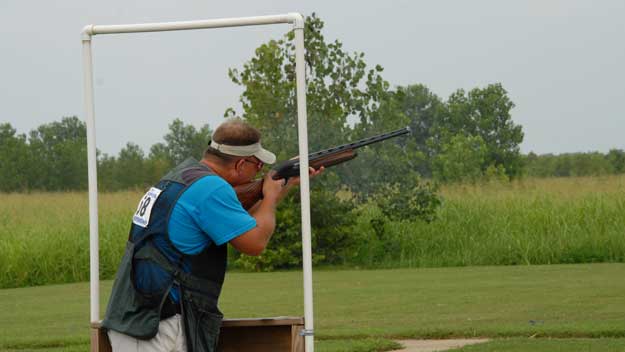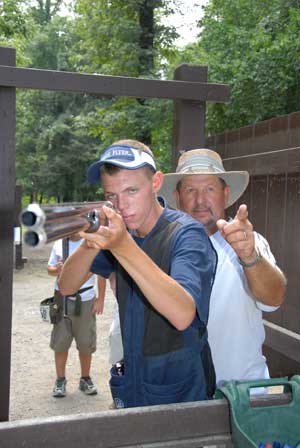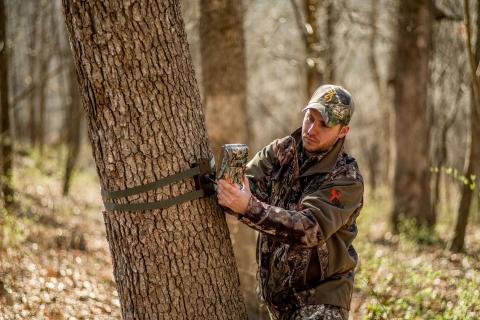
Shoot Trap, Skeet and Sporting Clays
By shooting trap, skeet and sporting clays, you learn how to continue to swing past the target and make the proper follow-through to shoot correctly when hunting doves. Once your mind learns how to see the proper lead and to continue the swing-through, then leading and shooting doves will become automatic and much easier for you.
If you're serious about your dove shooting, go to a trap, a skeet or a sporting-clay range. Have a qualified instructor watch you shoot. In 5 to 10 minutes, he'll be able to see the mistakes you're making and help you drastically increase your ability to shoot doves more proficiently.
Learn Why You're Missing
 A good wing-shooting instructor will be able to tell you whether you're shooting in front of or behind the targets and teach you the proper shooting position to correct your misses. He'll look at the way you mount the gun and watch the position of your head when you shoot. He'll notice if you pick your head up off the stock, which can cause you to miss. If you raise your head up even only a half inch above the rib, you'll shoot 3 feet high. Usually you won't be able to tell whether you're raising your head up or not. All you need to see when you shoot correctly is the bead of the shotgun and the bird. Taking a lesson or two from a shooting instructor will allow you to identify your mistakes and shoot more accurately when at a dove shoot.
A good wing-shooting instructor will be able to tell you whether you're shooting in front of or behind the targets and teach you the proper shooting position to correct your misses. He'll look at the way you mount the gun and watch the position of your head when you shoot. He'll notice if you pick your head up off the stock, which can cause you to miss. If you raise your head up even only a half inch above the rib, you'll shoot 3 feet high. Usually you won't be able to tell whether you're raising your head up or not. All you need to see when you shoot correctly is the bead of the shotgun and the bird. Taking a lesson or two from a shooting instructor will allow you to identify your mistakes and shoot more accurately when at a dove shoot.
Understand When to Shoot
Don't hesitate too long to shoot. Often a hunter waits until a dove is right on top of him before taking the shot. But the best place to try and bag a dove is when it's out in front of you. Probably the most difficult shot is attempting to take a dove when it's straight up over your head. Instead, try and shoot doves somewhat further away. Get into the proper shooting position before you squeeze the trigger. Then if the bird does start to dip to the left or the right, you may have time to compensate for the dove's movement, if it's further out in front of you instead of straight up over your head.
Remember, doves don't fly like clay targets. When they're riding the wind, zigging and zagging, you need to have enough time to compensate for their erratic flight before you squeeze the trigger. You won't have time to make those adjustments if you let the bird get too close. If I see a dove darting as it comes into the field, I plan to bag that dove when it's 20-30 yards out. Then my shot pattern can open out. Even if the bird does dart to the left or the right, there will be enough shot in the air to down it. When a dove is closer to you, your shot pattern is tighter, and the dove has a better chance of dodging the shot.
Know How to Take a Follow-Up Shot When Hunting Doves
After you have shot and missed a dove, forget about the first shot. Concentrate on the second shot. Make sure your cheek is still against the stock. Remember to swing your barrel out in front of the bird before you squeeze the trigger. Most of the time the second shot will be the most difficult to make. Since the bird is generally closer to you than when you’ve made your first shot, you'll tend to rush the second shot.
Determine Lead
Most shooters kill their doves within 25 to 30 yards of the shooter. Determining your lead depends on how strong the wind blows, how fast the dove flies, if the birds are flying with or against the wind, and what distance you are from the dove. Generally, if you attempt to bag doves from 25-30 yards, then lead the bird 3-4 feet. To learn to use a 4-foot lead, put two sticks on the ground 4 feet apart. Aim at the first stick, while looking at the second stick. This exercise will help you determine what a 4-foot lead looks like. If you aren't able to judge a 4-foot lead on the ground, you'll have a difficult time determining what a 4-foot lead is in the air.
It's important to use proper gun position, to learn where to point and find the best lead for you to be a successful dove hunter.



























